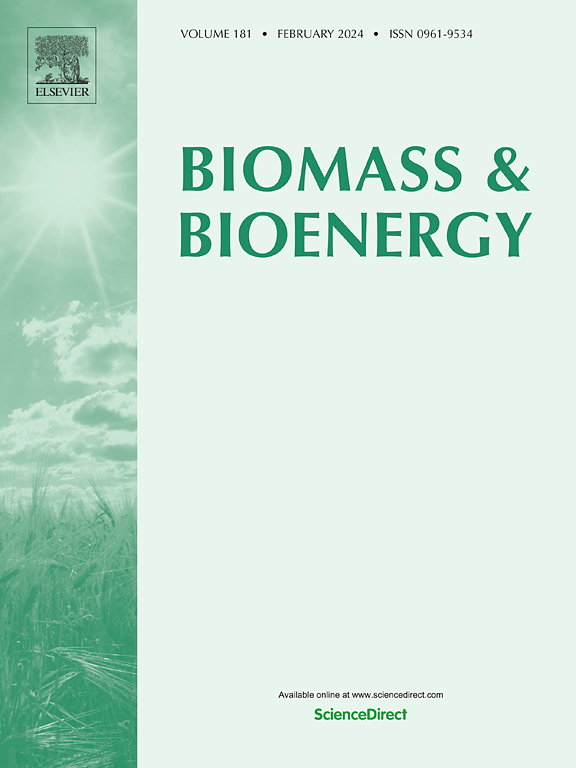Assessment of wood residue blends from the amazon region for decentralized energy recovery and decarbonization: Combustion kinetics, thermodynamics and potential emissions
IF 5.8
2区 生物学
Q1 AGRICULTURAL ENGINEERING
引用次数: 0
Abstract
Decentralized energy systems in the Amazon face challenges such as diesel dependence, high transport costs, and limited sustainability. Woody residues from sustainable forest management offer a viable bioenergy alternative, yet combustion kinetics, thermodynamics, and emissions data remain scarce. This study provides a comprehensive thermokinetic assessment of four blends comprising six Amazonian wood residues (Peltogyne lecointei, Erisma uncinatum, Martiodendron elatum, Handroanthus incanus, Dipteryx odorata, and Allantoma decandra) for decentralized energy solutions. Combustion kinetics were assessed through thermogravimetric analysis, isoconversional methods (Friedman, Flynn-Wall-Ozawa, Kissinger-Akahira-Sunose, and Starink), and DAEM approaches (Miura-Maki, Scott, and Three-Parallel). Additionally, combustion indexes, thermodynamic parameters, emissions, and carbon uptake were analyzed. Results highlighted differences in ignition and burnout performance, with some blends proving more efficient for energy recovery, while others exhibited prolonged combustion, affecting char formation and thermal stability. Experimental and predicted mass loss profiles strongly agreed (MAPE<6 %), confirming the kinetic approach's reliability. Enthalpy changes ranged from 112.89 to 441.90 kJ mol−1, while Gibbs free energy values of 163.25–248.55 kJ mol−1 confirmed a non-spontaneous process. Entropy variations from −116.31–431.54 J mol−1 K−1 indicated molecular disorder and energy efficiency during biomass decomposition. Emission factors for CO2 (67.109–69.773 tons MJ−1), SO2 (0.043–0.056 tons MJ−1), and NOx (0.008–0.011 tons MJ−1) were lower than fossil fuels. CO2 uptake (1.677–1.776 tons per ton of biomass) further supports carbon mitigation. Findings align with SDG7 (Affordable and Clean Energy) and SDG13 (Climate Action), promoting bioenergy integration into diesel-dependent systems in remote regions.

求助全文
约1分钟内获得全文
求助全文
来源期刊

Biomass & Bioenergy
工程技术-能源与燃料
CiteScore
11.50
自引率
3.30%
发文量
258
审稿时长
60 days
期刊介绍:
Biomass & Bioenergy is an international journal publishing original research papers and short communications, review articles and case studies on biological resources, chemical and biological processes, and biomass products for new renewable sources of energy and materials.
The scope of the journal extends to the environmental, management and economic aspects of biomass and bioenergy.
Key areas covered by the journal:
• Biomass: sources, energy crop production processes, genetic improvements, composition. Please note that research on these biomass subjects must be linked directly to bioenergy generation.
• Biological Residues: residues/rests from agricultural production, forestry and plantations (palm, sugar etc), processing industries, and municipal sources (MSW). Papers on the use of biomass residues through innovative processes/technological novelty and/or consideration of feedstock/system sustainability (or unsustainability) are welcomed. However waste treatment processes and pollution control or mitigation which are only tangentially related to bioenergy are not in the scope of the journal, as they are more suited to publications in the environmental arena. Papers that describe conventional waste streams (ie well described in existing literature) that do not empirically address ''new'' added value from the process are not suitable for submission to the journal.
• Bioenergy Processes: fermentations, thermochemical conversions, liquid and gaseous fuels, and petrochemical substitutes
• Bioenergy Utilization: direct combustion, gasification, electricity production, chemical processes, and by-product remediation
• Biomass and the Environment: carbon cycle, the net energy efficiency of bioenergy systems, assessment of sustainability, and biodiversity issues.
 求助内容:
求助内容: 应助结果提醒方式:
应助结果提醒方式:


